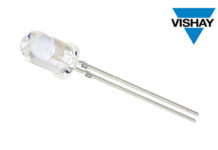
SweGaN AB today announced a new benchmark for GaN high-frequency devices based on SweGaN QuanFINE material. The demonstration promises commercial benefits for the entire GaN RF value chains including telecom, space, and military markets.
In a new joint study with the Chalmers University of Technology Department of Microtechnology and Nanoscience, SweGaN explored QuanFINE epitaxial wafer performance, based on GaN HEMT technology at Chalmers – Gothenburg, Sweden.
Collaborating with top scientists from the university, the team performed a new benchmark comparing the conventional 1.8 µm thick Fe-doped GaN buffer epi-structure to SweGaN’s ‘buffer-free’ QuanFINE GaN HEMT heterostructures for microwave applications.
The study revealed that the new concept using a total GaN layer thickness of 250 nm does not compromise the material quality and device performance. Furthermore, the device results indicate that the “buffer-free” QuanFINE material can outperform conventional materials at the device level in the long run.
For SweGaN customers and manufacturers, the ultimate benefits resulting from the new “buffer-free” concept include lower trapping, better carrier confinement and lower thermal resistance – could lead to higher device power efficiency and better reliability of GaN high-frequency devices.
- Findings from the research collaboration in IEEE Electron Device Letters (Early Access), DOI: 10.1109/LED.2020.2988074, “Microwave Performance of ‘Buffer-Free’ GaN-on-SiC High Electron Mobility Transistors”
- Joint research team: Ding-Yuan Chen, Anna Malmros, Mattias Thorsell, Member, IEEE, Hans Hjelmgren, Olof Kordina, Jr-Tai Chen, and Niklas Rorsman, Member, IEEE.
-” The new QuanFINE concept possesses many interesting features that are very attractive for both high frequency and power electronics, says Niklas Rorsman, Research Professor at Chalmers University of Technology. As an example, the possibility of a pure AlN back-barrier will be beneficial both for good electron confinement and thermal resistance. We at Chalmers are thrilled to be part of this development in GaN HEMT Technology.”
-“Currently, GaN-on-SiC epitaxial wafers for Ka band applications are either immature or suffer from severe trade-offs, says Dr. Jr-Tai Chen, CTO at SweGaN AB. Our QuanFINE epiwafers are a highly feasible solution that can resolve issues our customers are dealing with regarding short-channel effects in the high-frequency devices.”
-“We already have numerous product companies interested in our material as well as end users in the value chains, continues Dr. Chen. Four key target groups for QuanFINE epiwafers include the world’s leading foundries, IDMs (integrated device manufacturers), fabless companies, and end users, in Europe, Asia and USA. “
Key demonstrations from the joint collaboration
- Physical simulations (TCAD) indicated that QuanFINE can be highly favorable for improved electron confinement.
- Pulsed-IV measurements demonstrated a unique advantage of using the QuanFINE concept, showing a lower buffer-induced dispersion compared to the conventional thick, Fe-doped buffer.
- Large signal measurements demonstrate the QuanFINE concept can provide highly competitive output power levels and efficiency, vastly beneficial to product companies and end users.
According to SweGaN, the beauty of the QuanFINE concept is a thin undoped GaN channel layer in between an AlGaN barrier layer and a low TBR AlN nucleation layer which acts as a sandwich-like double heterostructure – offering sufficient 2DEG confinement with much lower trapping effects as compared to conventional Fe- and C-doped epi-structures. Moreover, the further reduction of GaN channel thickness will path a new road for small gate length device (Lg <150 nm) as compared to conventional AlGaN back-barrier epi-structure which suffers from weak thermal dissipation performance.
Further studies of the carbon impurity and the thickness of the UID GaN layer, are anticipated to continue to further improve the ‘buffer-free’ QuanFINE concept.
















